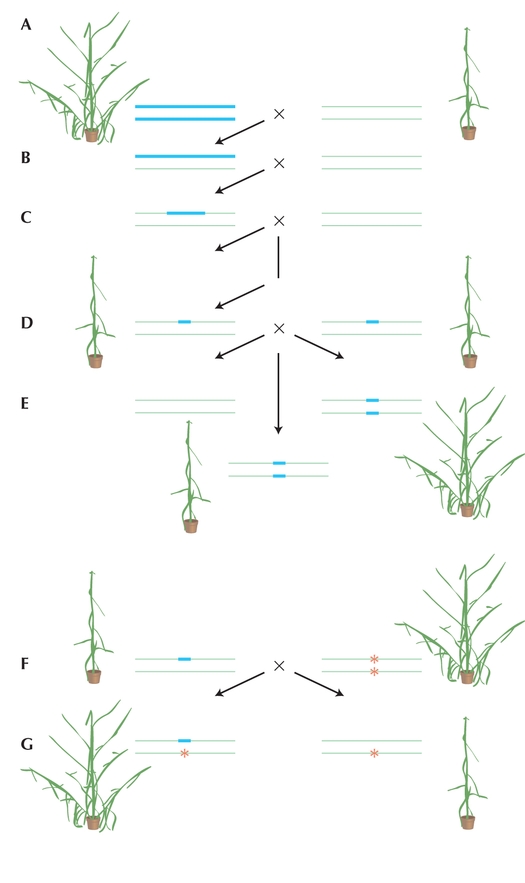

Figure WN14.3. Location of a QTL using the complementation method. (A) Doebley and colleagues (Doebley et al. 1995) crossed teosinte and maize to produce an F1 (B). This was backcrossed to maize; offspring were chosen that carried maize markers except in the region surrounding a QTL on chromosome 1. Ultimately, a cross between two offspring from the backcross generated a homozygous nearly isogenic line, which carried a small region of teosinte genome around the QTL. Heterozygotes for this region had the maize phenotype (D and E, middle), whereas homozygotes looked like teosinte (E, right). In other words, the teosinte allele of the QTL is recessive. The complementation test is made by crossing heterozygotes for the two alternative QTL alleles with a homozygote for the tbl1 mutation, which had arisen spontaneously in maize (F). Half of the offspring carried the recessive tbl1 mutant allele together with the maize allele of QTL and had a maize phenotype (G, right). The other half carried the teosinte QTL allele along with the tbl1 mutant (G, left). Crucially, these looked like tbl1 mutant homozygotes, with a teosinte-like phenotype. This shows that the different alleles fail to complement and so are likely to be at precisely the same genetic locus.
| © 2007-2010 by Cold Spring Harbor Laboratory Press. All rights reserved. |
| The reproduction, modification, storage in a retrieval system, or retransmission, in any form or by any means, electronic, mechanical, or otherwise, for reasons other than personal, noncommercial use is strictly prohibited without prior written permission. You are authorized to download one copy of the material on this Web site for personal, noncommercial use only. The material made available on this Web site is protected by United States copyright laws and is provided solely for the use of instructors in teaching their courses and assessing student learning. Dissemination or sale of any of this material, as a whole or in parts (including on the World Wide Web), is not permitted. All users of these materials and visitors to this Web site are expected to abide by these restrictions. Requests for permission for other uses of this material should be directed to Cold Spring Harbor Laboratory Press, 1 Bungtown Road, Cold Spring Harbor, NY 11724 or submitted via our World Wide Web Site at http://www.cshlpress.com/. |